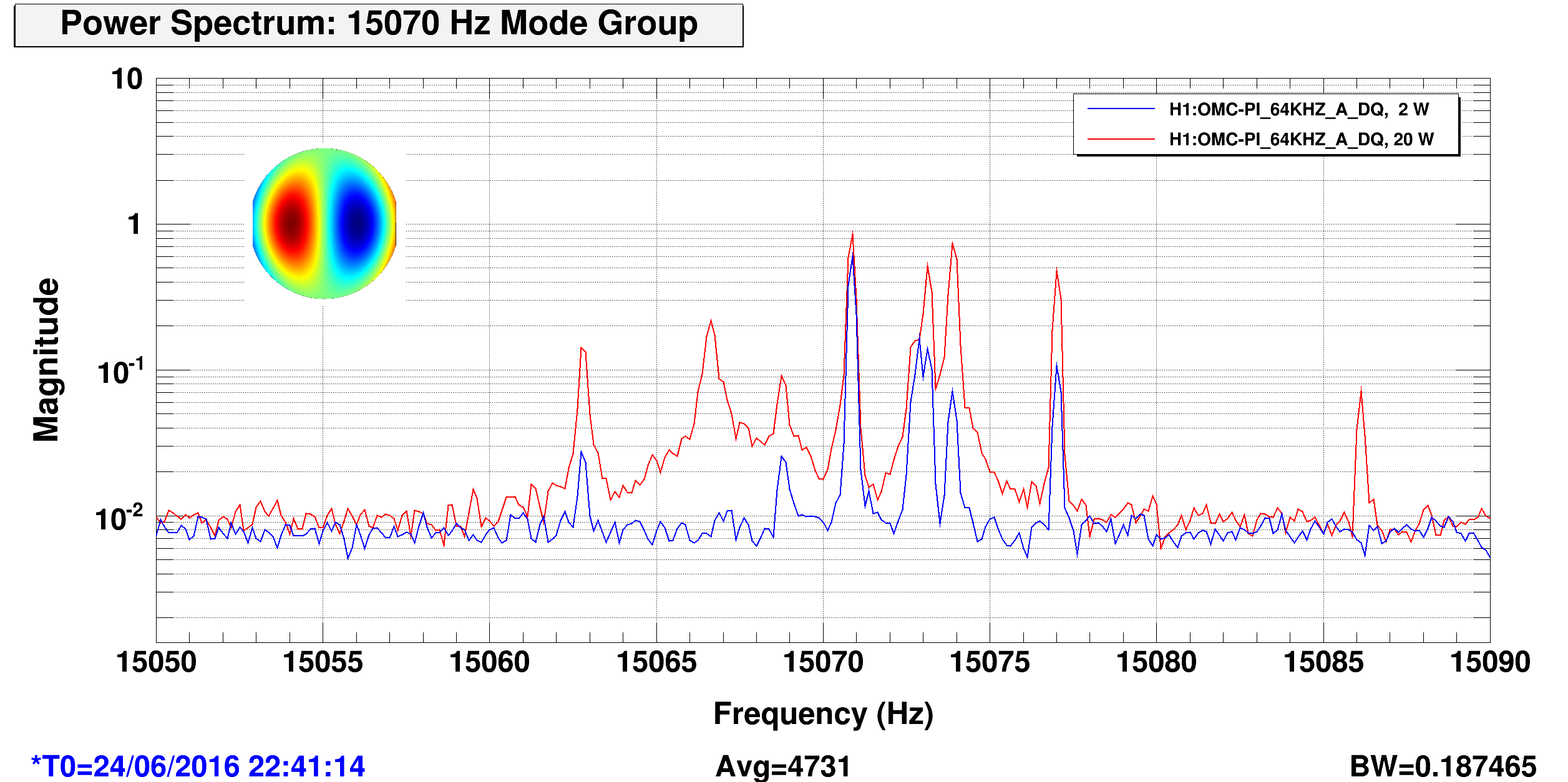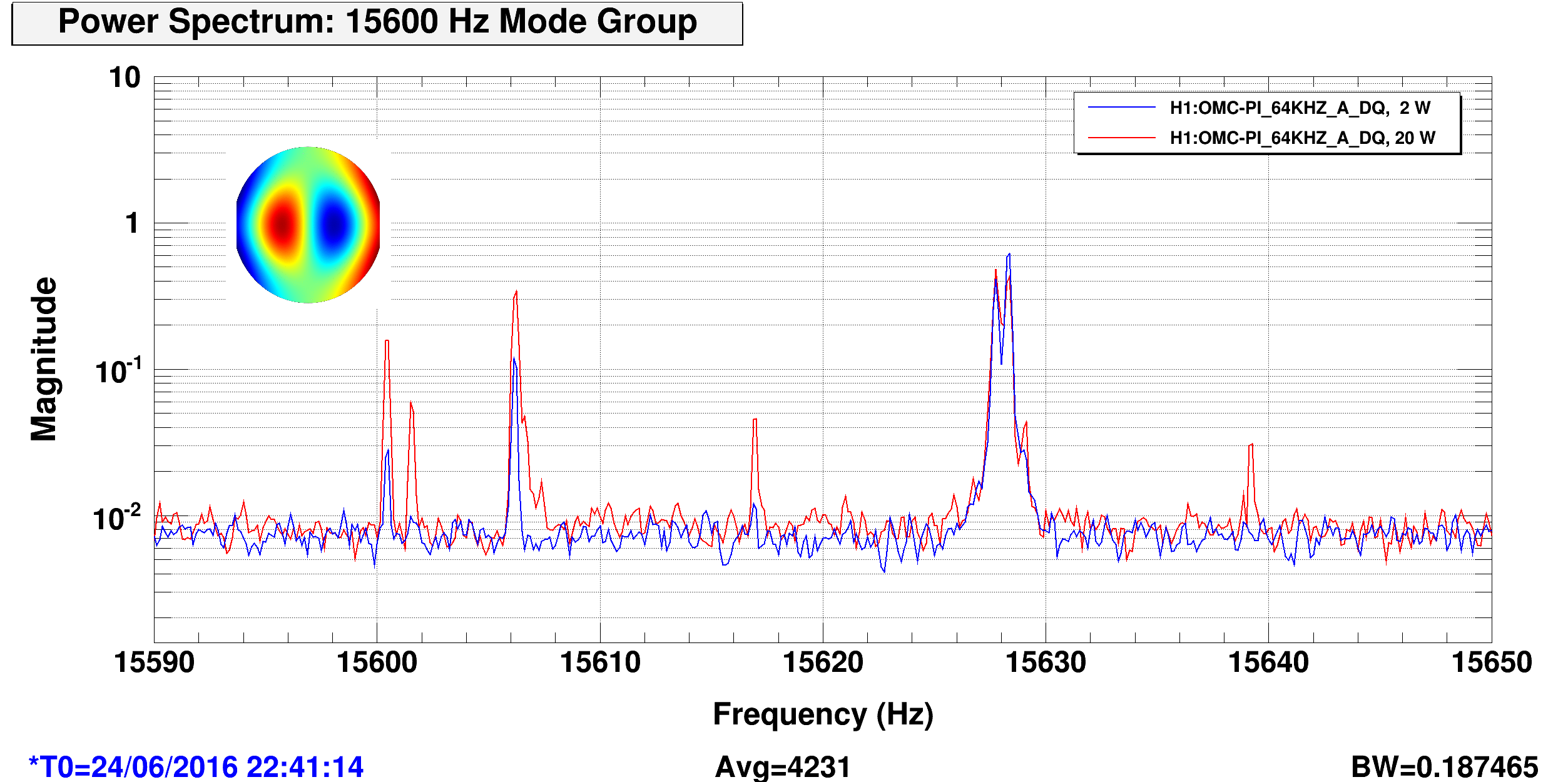We are seeing 8 peaks in at least two of the horizontal mechanical mode groups (instead of the expected 4, one for each test mass).
Below are spectra of the two mode groups as seen in the OMC DCPDs, taken while locked at 2 W and 20 W.


Compared to the 15000 vertical mode group here.
When I drove the 15070 Hz group:
- Driving ETMX with +/- 60 deg phase alternately rings up 15070.5 and 15073.5
- Driving ETMY with same - 60 deg phase and same sign rang up 15072.7 and 15066.6; flipping phase moved 15066.6 peak to right ~1 Hz
- Driving ITMX with opposite signs alternately rings up and damps 15063 and 15077 (alog 27659)
When I drove the 15600 Hz group:
- Driving each test mass with a wide BP over the whole mode group and trying different phases only rang up one peak each
- Driving ETMY rings up 15627.5 but also 15542 just as strongly, even though the latter is supposedly part of an orthogonal mode group
See wiki for frequencies I was able to drive and thus assign to a specific test mass.
Ideas:
- Mode splitting due to asymmetries in the test masses from ear placement, etc. However, Carl and Slawek both independently failed to see this result when adding asymmetries to their models.
- Violin mode coupling. However, by these high frequencies violin mode harmonics would cover a wide spread; would they not be just as likely to be seen in any mode group?
- PUM mechanical mode resonances coupling through the violin modes.
Maybe one more possibility; suppose the field you're monitoring is proportional to some LF (~ Hz) alignment dof for these, so the mode is only seen at +/- sidebands (i.e., suppressed-carrier AM) ?
Should not appear in arm cavity transmission (per Carl).
We investigated the scenario of these being amplitude modulation sidebands by looking at the arm transmission signal. If they were sidebands from an acoustic mode w1 with amplitude modulation of w2 from some lower frequency optic motion the OMC signal of A*sin(w1*t)*sin(w2*t) depicts the case when the motion moves the operating point around the point where there is zero response. In this scenario we would expect 2 sidebands and no w1 peak in the PSD of the OMC signal. We would expect the arm transmssion to be dominated by the w1 term (possibly with w2 sidebands. We drove up the 15606.2Hz peak.
Inspecting the arm tranmsisison signal we found that the 15606.2Hz peak appeared in the same location indicating that the the OMC signal we see is not an amplitude modulation sideband.
The scenarios investigated with COMSOL for possible mode splitting.
Nominal model 3D deformation depicted in the first figure. Dimensions for ITMY taken from 'galaxy' and D080751. RoC not included. Resonant frequency 15078.408Hz
Asymmetry in the ears vertical position + 2mm. Frequency shift to 15078.452Hz
Asymmetry in the ears horizontal position +2mm. Frequency shift to 15078.431Hz
Rotation of one ear by 5 degrees. Frequency shift to 15078.384Hz
Flats not centered in cylinder by +/-1mm (one flat larger area than other). Frequency shift to 15078.420Hz
Wedge angle misaligned from vertical (defined by flats) 10 degrees. Frequency shift to 15078.893Hz
None of these asymmetries produced new modes in the vicinity of the 15078Hz mode. And the frequency shifts are small relative to the observed frequency differences in the modes. These can be ruled out.
Idea of coupling via violin modes (29-31 harmonic) to the penultimate mass. There is relativly large motion of the ears for the horizontal modes which might explain the observation of mode splitting only in the horizontal modes.
ITMY PEN simulated resonant mode frequency is 15069.3Hz. (second figure).




